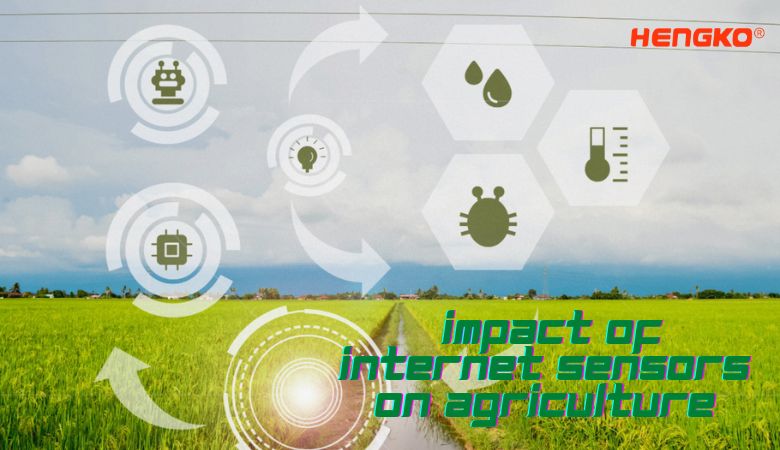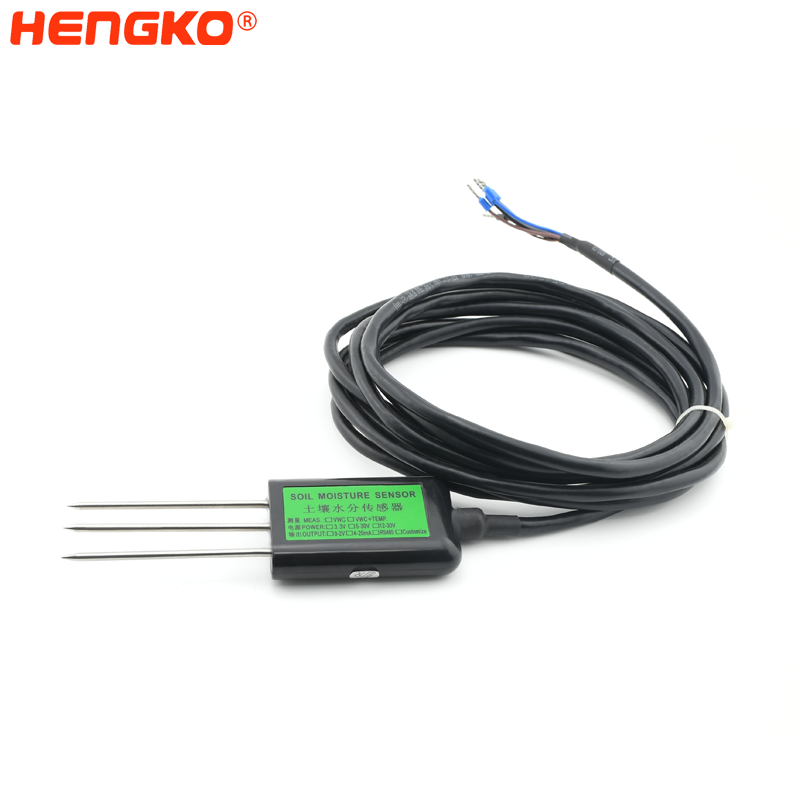
Internet technology and sensor technology, with the help of smart farming tools and practices such as farm management ERP, data collection sensors and automation, can enhance the advantages of agricultural technology. So for the most impact of internet sensor is that Developed countries are already using sensors to maximize agricultural efficiency.
What is the Benefits of Internet Sensors on Agriculture
Farmers can combine temperature and humidity sensors, soil sensors to observe crops in the field. Such as differences in soil or crop characteristics, air, soil, weather parameters, and crop status can be recorded and evaluated in real time, enabling more informed, immediate decisions.
1、 Disease outbreak warning
Due to the change of climate factors, global agriculture has been facing a severe situation. The rise in temperature also showed an adverse impact on crop yield, with a surge in new diseases and pests.
By addressing the impact of climate change, smart agriculture has proved to be a blessing for the agricultural community. Collect data from remote sensors with help. Farmers have used temperature and humidity sensors to monitor rainfall, temperature, humidity and other data to solve the problem of crop diseases. In this way, they can understand the susceptibility of crops to certain diseases and take timely action to prevent outbreaks.
2、 Efficient weeding
Smart agriculture has also enabled tools to help weed crops. Hoes equipped with weed detection cameras can help identify clear crop lines and navigate tools to carefully remove weeds without affecting standing crops. The use of drones for site-specific treatment of weeds and pests on large farms can help reduce the manual labor involved in the agricultural process and reduce the chance of yield damage.
3、 Water resources management
Irrigation automation is another important application of intelligent agriculture. The available water in an area can be detected by soil sensors and the water pressure of plants. HENGKO ht-706 soil moisture temperature sensor can be buried in the soil. By measuring the dielectric constant of the soil, it can directly and stably reflect the real moisture content of various soils.
The Internet infrastructure provides faster real-time connectivity and data transmission from the field to the server, helping to improve irrigation efficiency.
4、 Fertilization
In traditional farming methods, farmers apply fertilizer through drip irrigation or fertilization devices according to soil test and analysis. This is not very accurate. With fertilization equipment supporting the Internet of things (IOT), farmers can evaluate their farms from a distance and apply the appropriate amount of fertilizer through machines. Through the soil pH sensor, they can also see the current pH value of the soil.
5、 Crop monitoring
The difficulties involved in monitoring field activities, soil differences, available water, pests or disease outbreaks on large-scale farms are troublesome. But thanks to cheap drone technology and remote sensors that can monitor in time, farmers can closely monitor their crops without using a lot of manpower.
6、 Improve production efficiency
Intelligent agricultural technology also has great potential in maintaining the health and productivity of large animal farms. Smart farms can connect various machines and instruments in the farm, such as milking robots, feeding instruments, health status and Wi Fi collars, to help easily manage the farm. With data sources stored in the cloud, it can help ranchers or cattle farmers access animal health in real time. This helps maximize the use of resources, reduce pollution, reduce overhead costs, and improve animal welfare.
Types of Internet Sensors
Internet sensors, also known as web sensors or network sensors, are devices or software tools used to monitor and collect data about various aspects of the internet. They play a crucial role in gathering information for network analysis, security monitoring, and performance optimization. Here are some common types of internet sensors:
1. Network Traffic Sensors:
These sensors monitor and analyze network traffic data, such as packet-level information, bandwidth usage, and protocols used. They help in detecting anomalies, identifying network bottlenecks, and optimizing network performance.
2. Intrusion Detection Sensors:
These sensors are designed to detect and alert potential security breaches or unauthorized access attempts on a network. They analyze network packets or system logs to identify suspicious activities or patterns that may indicate an ongoing attack.
3. Web Application Sensors:
These sensors focus on monitoring web applications and their interactions. They can detect vulnerabilities, such as cross-site scripting (XSS) or SQL injection, and provide insights into the application's performance and user experience.
4. DNS Sensors:
Domain Name System (DNS) sensors monitor DNS queries and responses to identify potential security threats or performance issues. They can detect malicious domain resolutions, DNS cache poisoning attacks, or misconfigurations.
5. Wireless Sensors:
These sensors monitor wireless networks and collect data related to signal strength, interference, and device connectivity. They help optimize wireless network performance and troubleshoot connectivity issues.
6. Environmental Sensors:
These sensors monitor and collect data on environmental conditions, such as temperature, humidity, air quality, and power consumption in data centers or network infrastructure. They ensure optimal operating conditions and help prevent equipment failures.
7. Social Media Sensors:
These sensors collect and analyze data from social media platforms to gain insights into public sentiment, brand reputation, or emerging trends. They are used in social listening and market research.
8. Internet of Things (IoT) Sensors:
IoT sensors are embedded in various devices connected to the internet, such as smart home appliances, wearables, or industrial equipment. They collect data about device performance, usage patterns, or environmental conditions.
9. Geographic Sensors:
These sensors gather data related to the geographical location of network devices or users. They enable geolocation services, geofencing, or location-based advertising.
10. Cloud Monitoring Sensors:
Cloud sensors monitor virtualized environments and cloud infrastructure, providing visibility into resource usage, performance metrics, and service availability.
These are just a few examples of internet sensors, and there are many other specialized sensors depending on the specific monitoring requirements and objectives.
Why it is so important of Internet Sensor for Agriculture ?
Internet sensors play a crucial role in agriculture by providing valuable data and insights that help optimize farming practices, improve crop yields, and reduce resource consumption. Here's why internet sensors are important for agriculture:
-
Precision Monitoring: Internet sensors enable precise monitoring of various environmental factors such as temperature, humidity, soil moisture, and light levels. This data helps farmers make informed decisions about irrigation, fertilization, and pest control, ensuring optimal growing conditions for crops.
-
Resource Optimization: By continuously monitoring soil moisture levels and weather conditions, internet sensors help farmers optimize water usage and irrigation schedules. This not only conserves water but also prevents overwatering or underwatering, leading to more efficient use of resources and reduced costs.
-
Disease and Pest Management: Internet sensors can detect early signs of plant diseases or pest infestations by monitoring changes in environmental conditions or plant health parameters. This enables farmers to take timely action, implement targeted interventions, and minimize crop losses.
-
Crop Yield Prediction: By monitoring and analyzing data related to soil health, weather patterns, and plant growth parameters, internet sensors contribute to accurate crop yield prediction models. This information helps farmers estimate their harvests, plan logistics, and make informed decisions about pricing and market strategies.
-
Remote Monitoring and Automation: Internet sensors enable remote monitoring of agricultural operations, allowing farmers to keep track of multiple fields or greenhouses from a centralized location. This reduces the need for physical presence and enables real-time decision-making, saving time and effort.
-
Data-Driven Insights: Internet sensors generate a wealth of data that can be analyzed to gain valuable insights into crop performance, soil health, and environmental trends. By leveraging this data, farmers can make data-driven decisions, identify trends, and implement evidence-based farming practices for improved productivity.
-
Sustainability and Environmental Impact: Internet sensors help farmers adopt more sustainable and environmentally friendly practices by optimizing resource usage, reducing chemical inputs, and minimizing the environmental impact of farming operations. This contributes to long-term ecological balance and promotes sustainable agriculture.
-
Remote and Precision Farming: Internet sensors facilitate remote and precision farming techniques, such as drone-based monitoring, satellite imagery analysis, or autonomous farming equipment. These advanced technologies, enabled by internet sensors, improve efficiency, reduce labor requirements, and enhance overall farm productivity.
In summary, internet sensors are essential in agriculture as they provide real-time, accurate data about environmental conditions, crop health, and resource usage. By leveraging this information, farmers can make informed decisions, optimize farming practices, increase yields, reduce costs, and contribute to sustainable and efficient agricultural systems.
How to choose right internet sensor for agriculture ?
Choosing the right internet sensor for agriculture involves considering several factors that align with your specific farming needs and objectives. Here are some key considerations to help you choose the right internet sensor:
-
Identify Monitoring Needs: Determine the specific parameters you need to monitor in your agricultural operations. This could include soil moisture, temperature, humidity, light levels, rainfall, or other factors relevant to your crops and farming practices.
-
Scalability: Consider the scale of your farming operation. Determine whether you need a sensor solution that can monitor a small garden, a large field, or multiple locations simultaneously. Scalability is crucial to ensure the sensor system can accommodate your present and future needs.
-
Connectivity: Assess the available internet connectivity options in your farming area. Determine whether you have reliable access to Wi-Fi, cellular networks, or other internet connectivity options required for the sensors to transmit data to a central monitoring system.
-
Sensor Accuracy and Reliability: Look for sensors that provide accurate and reliable measurements. Check the specifications and reviews of the sensors to ensure they have a high level of precision and are built to withstand outdoor conditions, such as dust, moisture, and temperature variations.
-
Compatibility and Integration: Consider the compatibility of the sensors with your existing farm management systems or software. Ensure that the sensors can integrate with the platforms or tools you use for data analysis, visualization, and decision-making.
-
Power Source and Battery Life: Evaluate the power requirements of the sensors. Determine whether they can be powered by batteries, solar panels, or other renewable energy sources. Additionally, consider the expected battery life to minimize the need for frequent maintenance and replacement.
-
Data Management and Analysis: Assess the data management capabilities of the sensor system. Look for features that facilitate data storage, retrieval, and analysis. Consider whether the system provides visualizations, alerts, or data insights that can help you make informed decisions.
-
Cost and Return on Investment: Evaluate the cost-effectiveness of the sensor solution. Consider the initial investment, installation, and maintenance costs, as well as the potential return on investment in terms of increased crop yields, resource savings, or operational efficiencies.
-
Technical Support and Warranty: Check the availability of technical support from the sensor manufacturer or supplier. Ensure that the sensors come with a warranty or service agreement that covers any potential issues or malfunctions.
-
User-Friendliness: Consider the ease of installation, configuration, and use of the sensor system. Look for sensors that provide a user-friendly interface or mobile app for convenient monitoring and management.
By carefully considering these factors and evaluating the available options in the market, you can choose the right internet sensor solution that aligns with your agricultural needs, enhances productivity, and supports sustainable farming practices.
Still Have Any Questions Like to Know More Details For the Smart Agriculture , Please feel Free To Contact Us Now.
Also You Can Send Us Email Directly As Follow : ka@hengko.com
We Will Send Back With 24-Hours, Thanks for Your Patient !
Post time: Apr-09-2022







